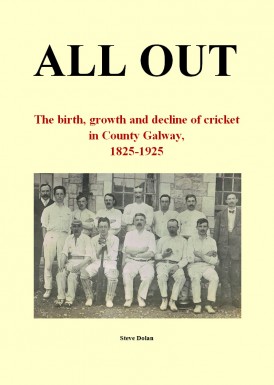All Out: The Birth, Growth and Decline of Cricket in County Galway, 1825-1925
David Wynne |Published: 2020
Pages: 84
Author: Dolan, Steve
Publisher: Dolan, Steve
Rating: 3.5 stars

It is now firmly established that cricket was the most popular sport in Ireland in the nineteenth century. The game largely fell out of favor in many many parts of the country in the twentieth, so it is easy to view it as being the almost solely the preserve of its strongholds in the North and East of the island, but Steve Dolan uncovers cricket’s rich heritage in County Galway in his new work All Out: The birth, growth and decline of cricket in County Galway, 1825-1925
The first cricket club in Ireland was in fact established in the county at Ballinasloe in 1825. Founded with the patronage of Lord Dunlo the success of the club made it clear that cricket existed outside of Dublin. With another club founded by Lord Clonbrock at Ahascragh the county had two influential benefactors who pioneered the organized sport in the years before the Great Famine. The early chapters show how this set a template for the game in the county of a reliance on the large estates.
As is so often the case, the history of cricket cannot be isolated from social and economic history. Though the game continued throughout the famine years, Dolan tells us that the decline in the fortunes of some estates in these years initially hindered further development of the sport, until a boom arrived in the 1860s.
This explosion, coupled with growing coverage of the game in the county by national press allows the author to illuminate the history of the sport in Galway. Scorecards, match reports and newspaper advertisements of the time are reproduced, and maps show the proliferation of clubs which began in the east, stretching across the county all the way to the Atlantic coastline on the west, before retreating after the peak of popularity in the late 1880s.
With an ever increasing cast of characters from the county now featuring, the author highlights the contributions of significant players such as Robert Algernon Persse, Francis Kilkelly and Jack Meldon. The latter is part of a dynasty whose contribution spans almost the entire history covered in this book. We learn of fascinating connections between notable players and important figures in national and sporting movements.
The increased coverage of the sport in this period allows a fascinating study of the type of person who played cricket at this time. While it never became the sport of the everyman, it certainly changed from its upper class origins to be at least more middle-class by the end of century.
Using data from the 1901 census Dolan is able to draw a picture of the typical cricketer as being better off, literate and more likely to be married than the average man, but also finds some surprises in the large proportion of Catholics, Gaelic speakers and farm workers who played cricket.
Cricket never developed along a county structure as it did in England, although a representative county Galway side did face other county teams. Nevertheless, we have been lucky to have in recent years a number of historians research the game in their respective counties in further detail. Pat Bracken in Tipperary, Tom Hunt in Westmeath and Micheal O’Dwyer in Kilkenny. This study is a vital companion to those and the history of sport in Ireland.
County sides were instead to become the staple of Gaelic Athletic Association. It is impossible to completely decouple the rise of Gaelic sports from discussion on cricket’s decline in Ireland, and while it is becoming increasingly clear that, nationally, cricket’s failure to capitalize on its popularity at the end of the nineteenth century was largely its own, this book tells us that cricket’s decline and legacy in Galway is more nuanced.
The Land Wars of the 1880s changed the relationship between the landlords who promoted the game and often provided the venues for the matches. Unlike in other counties, it was not competition from other sports, or the removal of army garrisons, but the vanishing of the large houses who supported the game that signalled the end for Galway as a force in cricket. The conclusions seek to untangle the complex relationships between cricket, nationalism, land and the GAA.
A collection of images puts faces to the names of some forgotten figures in the history of the game, and there is even one of the most famous, W.G. Grace, with hurler Ned Treston who is credited with creating the modern sliothar, the ball used in hurling.
At just 84 pages long, including notes, it might seem slight, but is rich in detail and would certainly number more pages if laid out in a more traditional format
Steve Dolan unearths nuggets of information on how Galwegians influenced the game from Ahascragh to Australia and Eyre Square to Buenos Aires. This is a wonderful little publication that throws light on the forgotten contribution of this corner of Ireland on cricket, both locally and globally.
Published for Heritage week, this is a special limited run of just 100 copies. All proceeds will go to support RSS schemes who played such a pivotal role in the county during the Covid-19 emergency.
To order a copy please contact the author at sakdolan@hotmail.com €10 + p&p



Leave a comment